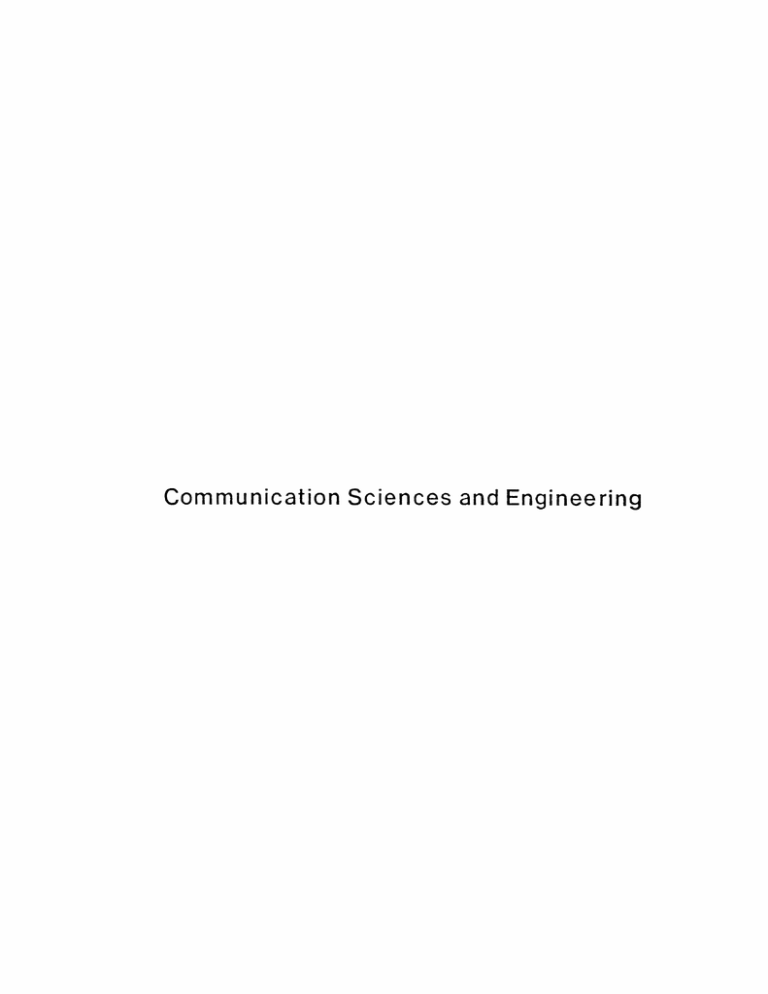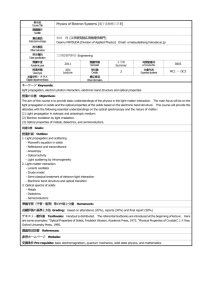Communication Sciences and Engineering
advertisement

Communication Sciences and Engineering Optical Propagation and Communication 20. Optical Propagation and Communication Academic and Research Staff Prof. R.S. Kennedy, Prof. J.H. Shapiro, Dr. R.H. Rediker, Dr. P.Kumar Graduate Students P.L. Bogler, R.S. Bondurant, J.J. Fratamico, F. Hakimi, S.T. Lau, M. Maeda, P.L. Mesite, T.T. Nguyen, J. Ocenasek, D.M. Papurt, J.J. Prisco, R.P. Schloss, P.D. Shapiro, S.S. Wagner, A.K. Wong The central theme of our programs has been to advance the understanding of optical and quasi-optical communication and radar systems. Broadly speaking, this has entailed: developing system-analytic models for important optical channels; using these models to derive the fundamental limits on system performance; and identifying, and establishing the feasibility of, techniques and devices which can be used to approach these performance limits. 20.1 Atmospheric Optical Communication Systems for Network Environments National Science Foundation (Grant ECS81-20637) Jeffrey H. Shapiro, Trung T.Nguyen, Albert K. Wong A local computer network is prototypically a high-bandwidth (1-10 Mb/s) geographically compact (0.1-10 km diameter) packet-switched network that employs coaxial cable or fiber optics as its transmission medium. Atmospheric optical communication links are a natural choice for certain high-bandwidth short-haul terrestrial transmission applications in which cable rights-of-way are unobtainable, or frequent link and network reconfiguration is necessary. Such links are therefore attractive candidates for local network applications including bridges between buildings containing cable subnetworks, and temporary quick-connects for new outlying users for which cable runs are unavailable. This program addresses the problem of how best to employ atmospheric optical communication links, which experience occasional outages due to local adverse weather conditions, in a local computer network, whose high-level protocols are designed to provide 100% end-to-end message reliability. The principal task for the past year has been the design and construction of a pair of 10 Mb/s atmospheric optical communication transceivers to be used, in succeeding years, in local network experiments on the M.I.T. campus. Each transceiver will use a 2 mW semiconductor laser collimator pen module in the transmitter, and an avalanche photodiode/preamplifier module in the receiver. In 127 RLE P.R. No. 125 Optical Propagation and Communication addition to the optical transceiver work, we have begun analysis on how atmospheric optical links can best be employed in various key network roles. 20.2 Atmospheric Propagation Effects on Infrared Radars U.S. Army Research Office - Durham (Contract DAAG29-80-K-0022) Jeffrey H. Shapiro, David M. Papurt, Sun T. Lau, Paula L. Mesite Compact coherent laser radars have the potential for greatly improved angle, range, and velocity resolution relative to their microwave-radar counterparts. This program is aimed at obtaining a quantitative understanding of target-reflection and atmospheric-propagation effects on the performance of compact coherent laser radars through a combination of theory and experiments. Under a collaboration arrangement with the Optics Division of the M.I.T. Lincoln Laboratory, the experimental portions of the research are being carried out on the compact C02-laser radars under development there. During the past year we have completed examination of the combined effects of turbulence and target speckle/glint on the performance of a 2-D pulsed-imager radar. 1-4 The principal conclusions drawn from this work are as follows. First, the compact radar system model must include beam jitter. Second, jitter-corrected glint target returns do show turbulence-induced lognormal scintillation. Third, turbulence-induced beam jitter is the cause for staring-mode speckle target decorrelation. The focus of our work has now shifted to moving-target indication (MTI) systems. In particular, we have begun to study many of the same turbulence and speckle issues as they impact the Lincoln 5 Laboratory continuous-wave CO2 laser heterodyne-reception Doppler radar. References 1. J.H. Shapiro and S.T. Lau, "Turbulence Effects on Coherent Laser Radar Target Statistics," Appl. Opt. 21, 2395-2398 (1982). 2. D.M. Papurt, "Atmospheric Effects on Heterodyne-Reception Optical Radars," Ph.D. Thesis, Department of Electrical Engineering and Computer Science, M.I.T., May 1982. 3. S.T. Lau, "Decorrelation Time of Speckle Targets Observed with a Heterodyne-Reception Optical Radar," S.M. Thesis, Department of Electrical Engineering and Computer Science, M.I.T., June 1982. 4. D.M. Papurt, J.H. Shapiro, and S.T. Lau, "Measured Turbulence and Speckle Effects in Laser Radar Target Returns," Proc. SPIE 415, (1983). 5. D.G. Biron and B.E. Edwards, "Moving Target Imaging Radar Utilizing Both Intensity and Velocity Information," CLEO 1982 Technical Digest, (Opt. Soc. of Am., Pheonix, Arizona, 1982) pp. 128-129. RLE P.R. No. 125 128 Optical Propagation and Communication 20.3 Improved Millimeter-Wave Communication Through Rain U.S. Navy - Office of Naval Research (Contract N00014-81-K-0662) Jeffrey H.Shapiro, John J. Fratamico, Philip L. Bogler The increased path loss due to rain has long been recognized as a key factor limiting the extension of microwave satellite communications into the millimeter-wave spectral band. This program is aimed at understanding the extent to which millimeter-wave communication performance under severe rain conditions can be improved through exploitation of multiply-scattered radiation. Toward this end we have developed efficient numerical procedures for solving the scalar transport equation for the total transmission, angular spread, multipath spread, and Doppler spread of the multiply-scattered radiation. 1 Evaluation of these parameters has been performed for propagation at 35, 44, 95, 130, 210, and 300 GHz in various rain rates. 1 We have combined the preceding propagation work with the appropriate communication analysis2,3 for the millimeter-wave channel and reached the following conclusions. In a heavy rainstorm a satellite-to-ground link at 95 GHz or above which has sufficient power for multi-Mb/s communication in clear weather may have sufficient power for multi-Kb/s communication if adaptive angle diversity reception of the scattered radiation is employed. Direct-beam reception will not function at these data rates, nor will nonadaptive angle diversity reception. The array needed for the adaptive combiner is far beyond the current state of the art, but may evolve out of the need for phased arrays to be used in millimeter-wave radars. References 1. J.J. Fratamico, "Millimeter-Wave Propagation through a Turbid Atmosphere," Ph.D. Thesis, Department of Electrical Engineering and Computer Science, M.I.T., November 1982. 2. J.J. Fratamico, P.L. Bogler, and J.H. Shapiro, "Adaptive Diversity-Combining for Improved Millimeter-Wave Communication through Rain," IEEE J.Sel. Areas in Commun. SAC-I1, (1983). 3. P.L. Bogler, "Electromagnetic Wave Propagation in Multiple-Scattering Atmospheres with Applications to Adaptive Communication," Ph.D. Thesis Proposal, Department of Electrical Engineering and Computer Science, M.I.T., January 1983. 20.4 Two-Photon Coherent State Light U.S. Navy - Office of Naval Research (Contract N00014-81-K-0662) Jeffrey H. Shapiro, Prem Kumar, Roy S. Bondurant, Mari Maeda, Stuart S. Wagner Recent theory has shown that the generation of light beams with quantum states of superior fluctuation behavior may be possible. These states, called two-photon coherent states (TCS), are minimum uncertainty states of the electromagnetic field processing an asymmetric noise division 129 RLE P.R. No. 125 Optical Propagation and Communication between the quadratures. The purpose of this research is to generate TCS light via degenerate four-wave mixing in sodium vapor, and to verify some of the predicted TCS fluctuation characteristics via photon counting measurements. During the past year we have: set up the mixer and verified conjugate-wave generation; developed a photon counting scheme for making accurate statistical measurements on nanosecond duration optical pulses;1 and devised a pulse-conditioning technique to minimize excess noise in the four-wave mixer output beams. 2 Work is now proceeding on quantum-noise measurements. In addition to the main experimental effort we have begun analysis of the use of TCS light in phase-sensing interferometers 3 and of fundamental limits in phase/amplitude heterodyne measurements. 4 References 1. R.S. Bondurant, P. Kumar, J.H. Shapiro, and M.M. Salour, "Photon-Counting Statistics of Pulsed Light Sources," Opt. Lett. 7, 529-531 (1982). 2. P.Kumar and R.S. Bondurant, "Improving the Pulse Shape in Dye Laser Amplifiers: A New Technique," Appl. Opt. 22, 1284-1287 (1983). 3. R.S. Bondurant, "Theoretical and Experimental Aspects of Quantum Noise Reduction and Precision Measurement," Ph.D. Thesis Proposal, Department of Electrical Engineering and Computer Science, M.I.T., November 1982. 4. S.S. Wagner, "An Investigation of the Uncertainties in Signal Energy and Phase in Optical Detection," S.M. Thesis, Department of Electrical Engineering and Computer Science, M.I.T., September 1982. 20.5 Fiber-Coupled External-Cavity Semiconductor High-Power Laser U.S. Navy - Office of Naval Research (Contract N00014-80-C-0941) Robert H.Rediker, Robert P. Schloss, Farhad Hakimi During the past year an external cavity to contain five semiconductor gain elements operating in parallel has been designed and built. A photograph of this cavity isshown in Fig. 19-1. Starting from left to right the first plate attached to the four Super-Invar rods holds the micromanipulators and piezo-electric elements which will be used to properly position the gain elements. In back of this plate are the thermoelectric elements which are used to control individually the temperature of each element. The thermoelectric elements are connected to the gain elements by a flexible copper strap. The next plate will contain a lens which focuses all the collimated radiation from the gain elements on the spatial filter to be held by the third plate from the left. The spatial filter which contains thirteen 3 pim slits on 10.5 pm centers isthe Fraunhoffer diffraction pattern of the gain elements' radiation if these elements are emitting in coherence. Filters have been built for us of blackened Si2N3 by integrated circuit techniques. The single pass transmission of the filter for coherent radiation input RLE P.R. No. 125 130 Optical Propagation and Communication from the five elements is -3 times that if the radiation is incoherent. The next plate will contain a lens to recollimate the radiation; the last plate will contain a partially reflecting mirror. Figure 20-1: Photograph of External Cavity Thermoelectric control circuits with sensors have also been built to control the temperature of each semiconductor gain element to 0.5 x 10.30C. (This temperature control is equivalent to controlling the 820-nm wavelength of the gain element radiation to 3 x 10'5 nm.) This sophisticated control will enable us to tune and detune the output wavelength of each element if the element were operating by itself. We will thus be able to quantify the tolerance for "locking into coherence" to wavelength variations. The sophisticated positioning controls in the cavity shown in Fig. 20-1 will enable us to also quantify the mechanical tolerances for "locking into coherence". These tolerances will give an indication of the ease with which this "high-power-laser" concept can be taken from laboratory to general use. 131 RLE P.R. No. 125 RLE P.R. 125 132



